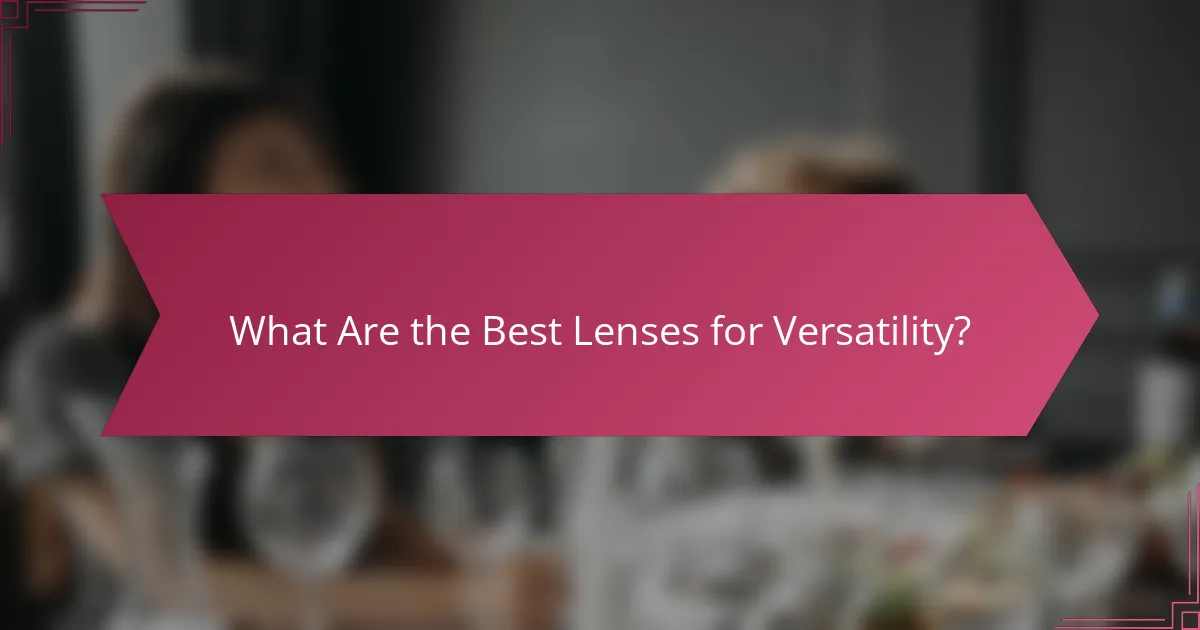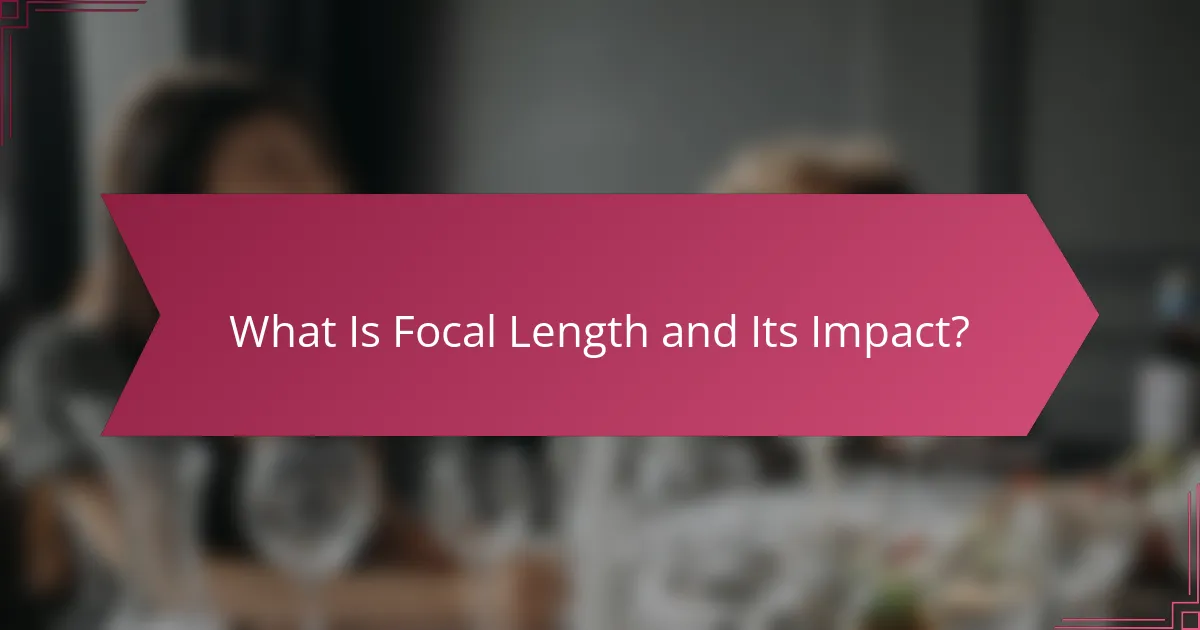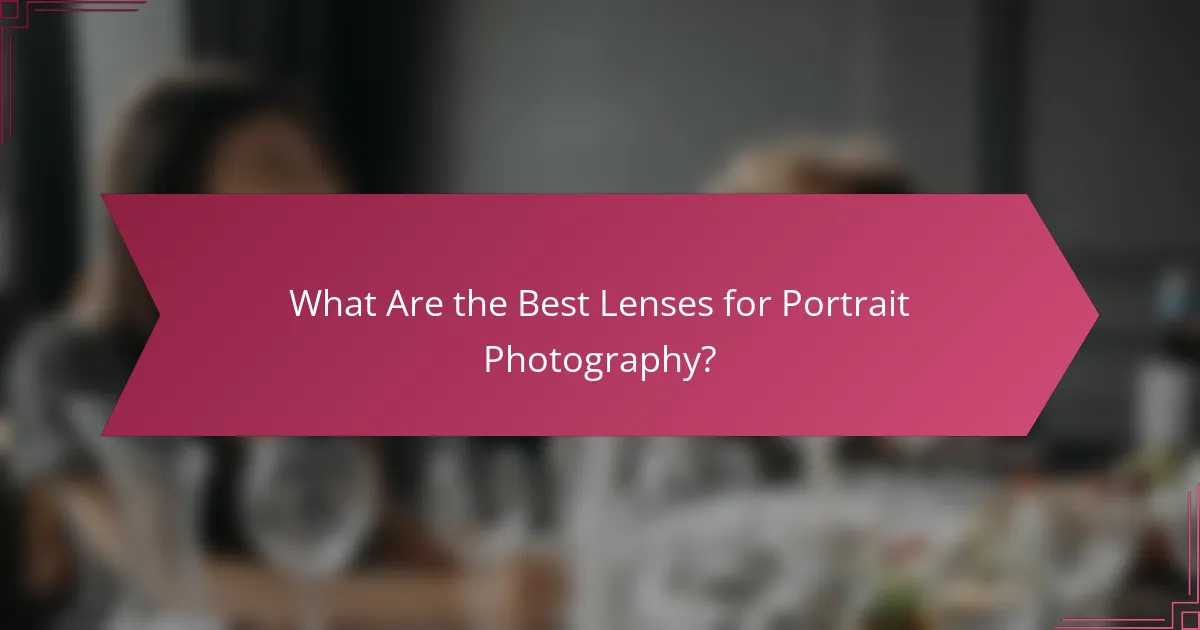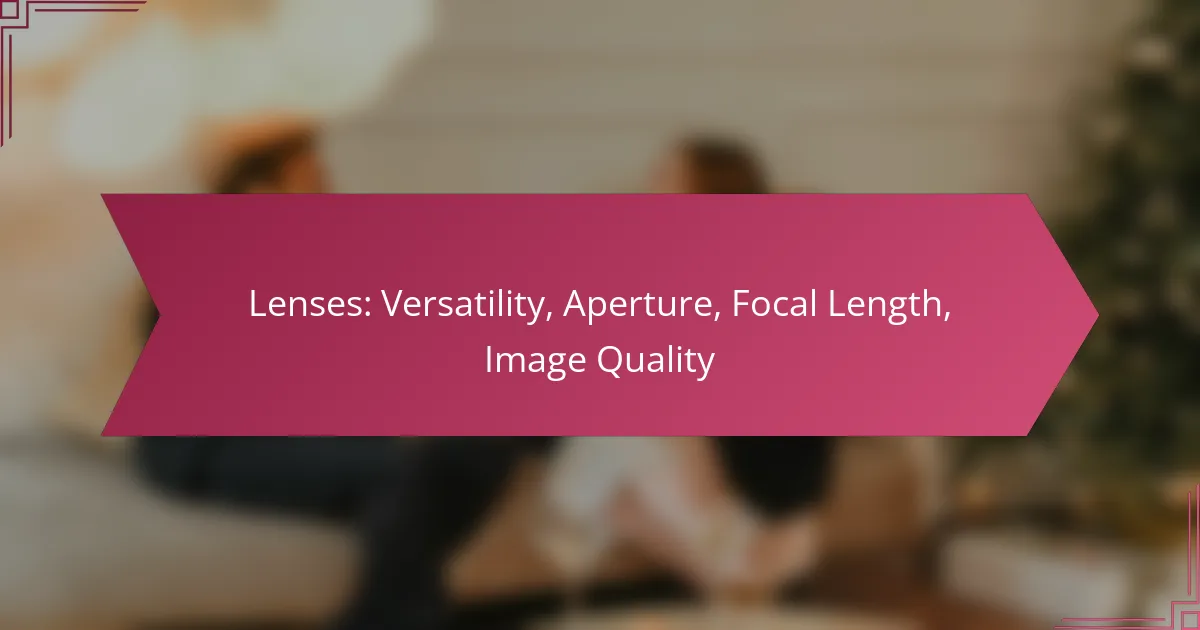Lenses play a crucial role in photography, offering versatility through various focal lengths and apertures to suit different shooting scenarios. The choice of lens affects not only the composition and perspective of images but also their overall quality, as aperture settings influence light intake and depth of field. Understanding these elements allows photographers to make informed decisions that enhance their creative expression.

What Are the Best Lenses for Versatility?
The best lenses for versatility are typically zoom lenses that cover a range of focal lengths, allowing photographers to adapt to various shooting situations. These lenses often balance image quality, aperture, and ease of use, making them ideal for both amateur and professional photographers.
Canon EF 24-70mm f/2.8L II USM
The Canon EF 24-70mm f/2.8L II USM is a highly regarded lens known for its sharpness and fast aperture. With a focal length that covers wide-angle to short telephoto, it is suitable for landscapes, portraits, and events.
This lens features a constant f/2.8 aperture, allowing for excellent low-light performance and depth of field control. Its robust build quality also ensures durability in various shooting conditions.
Nikon AF-S NIKKOR 24-120mm f/4G ED VR
The Nikon AF-S NIKKOR 24-120mm f/4G ED VR offers a versatile zoom range with a constant f/4 aperture, making it a great choice for travel and everyday photography. This lens excels in providing a good balance between wide-angle and telephoto capabilities.
Its Vibration Reduction (VR) technology helps reduce camera shake, making it easier to capture sharp images in lower light. This lens is particularly beneficial for those who prefer a lightweight option without sacrificing image quality.
Sony FE 24-105mm f/4 G OSS
The Sony FE 24-105mm f/4 G OSS lens is designed for full-frame mirrorless cameras, providing a versatile zoom range ideal for various photography styles. Its constant f/4 aperture allows for consistent exposure throughout the zoom range.
This lens features Optical SteadyShot (OSS) for stabilization, enhancing handheld shooting capabilities. Its compact design and high-quality optics make it a popular choice among photographers looking for a reliable all-in-one solution.

How Does Aperture Affect Image Quality?
Aperture significantly influences image quality by controlling the amount of light entering the lens and affecting depth of field. A wider aperture can enhance low-light performance and create a more pronounced background blur, while a narrower aperture increases sharpness across the image but may require longer exposure times.
Wider apertures allow more light
A wider aperture, indicated by a lower f-stop number (e.g., f/1.4, f/2.8), permits more light to reach the camera sensor. This is particularly beneficial in low-light conditions, allowing for faster shutter speeds and reducing the risk of motion blur. For instance, using an aperture of f/2.8 instead of f/5.6 can double the light hitting the sensor, making a significant difference in darker environments.
However, while wider apertures improve light intake, they can also introduce challenges such as lens aberrations and reduced sharpness at the edges of the frame. It’s essential to balance the aperture setting with other factors like shutter speed and ISO to achieve optimal image quality.
Shallower depth of field
A wider aperture results in a shallower depth of field, which means that only a small portion of the image will be in sharp focus while the background becomes more blurred. This effect is often used in portrait photography to isolate the subject from the background, creating a more aesthetically pleasing image. For example, shooting at f/1.8 can produce a beautifully blurred background that emphasizes the subject.
While a shallow depth of field is desirable for certain styles, it can be challenging to achieve focus on moving subjects or when composing group shots. Photographers should practice focusing techniques and consider using a tripod to maintain stability when working with wide apertures to avoid unintentional blurriness.

What Is Focal Length and Its Impact?
Focal length refers to the distance between the lens and the image sensor when the subject is in focus, significantly influencing the composition and perspective of photographs. It is typically measured in millimeters (mm) and affects how much of a scene is captured and how objects appear relative to each other.
Defines field of view
The focal length of a lens directly determines its field of view, which is the extent of the scene captured in the frame. Shorter focal lengths, such as 18-35mm, provide a wider field of view, making them ideal for landscapes and architecture. Conversely, longer focal lengths, like 70-200mm, narrow the field of view, allowing for tighter compositions and isolating subjects from their backgrounds.
When selecting a lens, consider the type of photography you intend to pursue. For instance, if you want to capture expansive vistas, a wide-angle lens is essential, while a telephoto lens is better suited for wildlife or sports photography where distance is a factor.
Affects perspective and composition
Focal length not only influences the field of view but also affects perspective and composition in photography. Wide-angle lenses can exaggerate depth, making foreground subjects appear larger and background elements smaller, which can create a sense of depth. In contrast, telephoto lenses compress space, making objects appear closer together than they are, which can be useful for creating a more intimate composition.
When composing your shots, be mindful of how focal length impacts the visual narrative. For example, using a wide-angle lens for street photography can capture the environment and context, while a longer lens can focus on details or expressions, telling a different story. Experimenting with various focal lengths will help you understand their effects on your images.

How to Choose the Right Lens for Your Needs?
Choosing the right lens depends on your photography style, the compatibility with your camera, and the specific features you need, such as aperture and focal length. Consider what you want to achieve with your images to guide your selection process.
Consider your photography style
Your photography style significantly influences the type of lens you should choose. For instance, if you enjoy landscape photography, a wide-angle lens with a low aperture is ideal for capturing expansive scenes. Conversely, portrait photographers often prefer lenses with longer focal lengths to achieve beautiful background blur.
Additionally, think about the subjects you frequently shoot. For wildlife photography, a telephoto lens allows you to capture distant animals without disturbing them. If you often shoot in low-light conditions, a lens with a larger maximum aperture will help you achieve better results.
Evaluate compatibility with your camera
Ensuring that your chosen lens is compatible with your camera body is crucial. Different camera brands and models have specific mounts, so check that the lens fits your camera’s mount type. For example, Canon and Nikon have distinct mounts that require lenses designed specifically for them.
Furthermore, consider the sensor size of your camera. Full-frame cameras can utilize both full-frame and crop-sensor lenses, while crop-sensor cameras should ideally use lenses designed for their format to avoid vignetting. Always verify compatibility to avoid purchasing a lens that won’t work with your setup.

What Are the Key Attributes of High-Quality Lenses?
High-quality lenses are defined by their optical clarity, build quality, and overall performance. These attributes significantly impact image quality, making them essential for photographers and videographers seeking to achieve professional results.
Optical clarity and sharpness
Optical clarity and sharpness are critical for producing high-resolution images with fine detail. Lenses with advanced coatings and high-quality glass elements minimize distortion and aberrations, resulting in clearer images. Look for lenses with low dispersion glass and multi-layer coatings to enhance light transmission and reduce glare.
When assessing sharpness, consider testing lenses at various apertures. Many lenses perform best at mid-range apertures, typically between f/5.6 and f/8, where they achieve optimal sharpness across the frame. Always review sample images to gauge a lens’s performance in real-world conditions.
Build quality and durability
Build quality and durability are essential for ensuring that lenses withstand regular use and various environmental conditions. High-quality lenses often feature weather-sealing, robust materials, and metal mounts, which enhance their longevity. Consider investing in lenses that are designed for outdoor use if you frequently shoot in challenging environments.
Additionally, pay attention to the weight and size of the lens. Heavier lenses may offer better stability and durability but can be cumbersome for extended use. Always balance the need for durability with portability based on your shooting style and preferences.

What Are the Best Lenses for Portrait Photography?
The best lenses for portrait photography typically have a focal length between 85mm and 135mm, allowing for flattering perspectives and beautiful background blur. A wide aperture, such as f/1.2 or f/1.4, enhances subject isolation and creates a soft bokeh effect, making the subject stand out.
Canon EF 85mm f/1.2L II USM
The Canon EF 85mm f/1.2L II USM is renowned for its exceptional image quality and sharpness, making it a top choice for portrait photographers. Its wide f/1.2 aperture allows for stunning depth of field and excellent performance in low-light conditions.
This lens features a fast and accurate autofocus system, which is crucial for capturing fleeting expressions. However, its size and weight may be a consideration for those looking for a more portable option.
Nikon AF-S NIKKOR 85mm f/1.4G
The Nikon AF-S NIKKOR 85mm f/1.4G is another excellent lens for portrait photography, offering a slightly narrower aperture than the Canon but still delivering impressive sharpness and color rendition. Its f/1.4 aperture provides a beautiful bokeh while maintaining good subject detail.
This lens is well-regarded for its build quality and durability, making it suitable for both studio and outdoor shoots. While it may not focus as quickly as some competitors, its optical performance makes it a worthy investment for serious portrait photographers.
